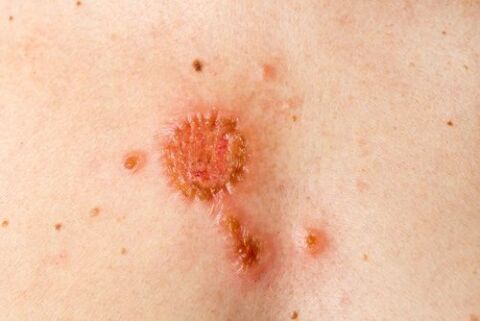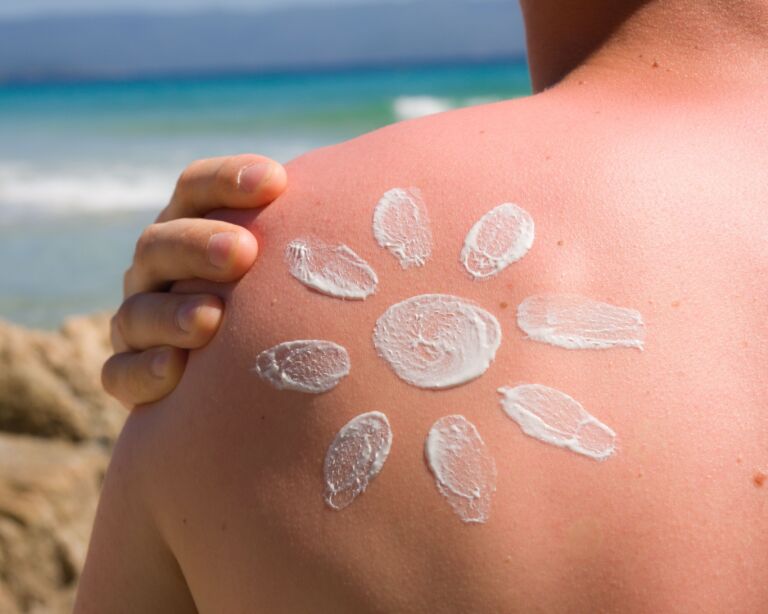In Switzerland, it is estimated that between 20,000 and 25,000 people develop white skin cancer every year. The cause is always many years of intensive UV radiation. As a rule, older people fall ill. If white skin cancer is detected and treated early, there is a good chance of recovery.
White skin cancer: basal cell carcinoma
A basal cell carcinoma develops in the basal cells of the epidermis. This skin change usually occurs in the head and neck area, i.e. in places that are frequently exposed to the sun, usually without protection. The intensive UV radiation causes the basal cells to degenerate and they begin to proliferate in various forms into the surrounding tissue. The skin change does not cause any symptoms for a long time, sometimes the area starts to itch or bleed.
A basal cell carcinoma is a malignant tumor that can spread from its site of origin into the width and depth of the tissue and even affect bone and cartilage. It grows relatively slowly, often over years and decades, and only very rarely forms metastases. Men and women suffer from it in roughly equal numbers.
If the basal cell carcinoma is detected and removed early, the chances of recovery are good. For every 1,000 people affected, only one or one dies as a result of the disease. A basal cell carcinoma develops as a small inconspicuous nodule, there is no precancerous stage, the growth is immediately malignant. Basal cell carcinoma is usually not changed in color, so that the skin change is hardly noticeable – hence the name white skin cancer.
The risk of disease is high for:
- People with fair skin,
- People who spend a lot of time in the sun at work,
- unprotected exposure to the sun,
- Sunburns in childhood,
- frequent visits to the solarium and
- genetic or familial predisposition.
Those affected usually fall ill between the ages of 60 and 70. Excessive sunbathing and frequent visits to the solarium mean that younger people are also increasingly developing basal cell carcinomas.
Recognizing white skin cancer

The development of white skin cancer is closely linked to long-term exposure to the sun and other risk factors.
White skin cancer: symptoms
Basal cell carcinomas are hardly noticeable at first and do not cause any symptoms. Those affected suspect that the skin change is a pimple or a small inflammation. In addition, basal cell carcinomas can look very different and therefore cannot be clearly identified. In addition, they start very small and often grow slowly over years.
What are the precursors of white skin cancer?
White skin cancer (sometimes also known as “light skin cancer”) can occur in the form of precursors known as actinic keratoses or Bowen’s disease. These skin changes are often caused by chronic sun exposure and can develop into basal cell carcinomas or squamous cell carcinomas over time. Early detection and treatment of precancerous lesions is crucial to prevent the development of skin cancer.
Some characteristic features are
- Edge hem with small dots reminiscent of a string of pearls,
- red spots with a scabby appearance,
- small shiny nodules that bulge in the center, form a crater and ooze
- and inconspicuous, skin-colored hardening of the tissue.
Experts differentiate between four forms of basal cell carcinoma and, due to the malignant nature of the tissue change, increasingly refer to it as basal cell carcinoma.
- superficial trunk skin basal cell carcinoma
- nodular basal cell carcinoma
- tumor-like basal cell carcinoma
- scar-like basal cell carcinoma
If left untreated, the changes in the surface will continue to grow and eventually extend into the depths. The surface of the basal cell carcinoma may be repeatedly covered with a crust and resemble a skin abrasion or eczema. The spots rarely itch and those affected do not complain of pain.
What are the symptoms of white skin cancer?
The symptoms of white skin cancer can vary, but they are often inconspicuous and painless. Typical signs are small, shiny, pearly or skin-colored nodules that grow slowly, as well as open ulcers or scaly patches of skin that do not heal. If skin cancer is suspected, early medical clarification is crucial.
Suspicious symptoms can be
- Small, scabby spots that do not heal for weeks
- reddish areas with a beaded edge
- shiny, hemispherical nodules
- rough or scar-like changes
- skin-colored thickenings
Which parts of the body are most affected?
The face is a frequently affected region for white skin cancer, as it is often exposed to the sun. The changes are typically found on the ears, forehead and neck, but they can also occur on the hands, chest or torso. Observe the conspicuous areas of skin over a certain period of time (four weeks) and see a doctor if the symptoms do not subside. A dermatological examination if skin cancer is suspected is particularly important, as early measures increase the chances of treatment.

Basal cell carcinoma – what you can do yourself for early detection
The earlier a basal cell carcinoma is treated, the better. If the altered skin structures have already spread, it becomes more difficult to remove the areas without major scarring. You can do a lot to prevent this yourself. This includes protection against excessive UVA and UVB rays. The UVB rays help the body to produce the important vitamin D, but they also cause sunburn. UVA rays penetrate into the deeper layers of the skin, causing skin ageing and irreversible damage. It is important to know that UVA rays are not blocked by clouds or glass. You can do this to protect yourself from intense sunlight:
- Use sun cream with UVA and UVB protection and a high sun protection factor
- Protect your head, face and arms with suitable clothing
- Prefer shade, avoid midday sun
- Wear sunglasses with UV protection
- do without a solarium
Online skin check: Quick and convenient from home
Send a photo of the affected skin area and fill out the short questionnaire. Within 24 hours on weekdays, you will receive a reliable diagnosis from our experts. Your data will be transmitted to us encrypted and treated confidentially.
Basal cell carcinoma: causes and risk factors
Anyone who exposes their skin to the sun intensively over a long period of time runs the risk of developing basal cell carcinoma. Therefore, protect the areas of skin that are exposed to sunlight whenever you are outdoors: Forehead, cheeks, hands, throat and neck as well as the bald head. Especially if you are one of the light-colored types with
- blue, gray or green eyes
- reddish, blond or light brown hair and
- fair skin that is prone to sunburn,
you should be careful with the sun. Every intense sun exposure damages the structure of the basal cells, it does not necessarily have to be a real sunburn, the redness alone shows that the skin has already had more than enough. The cells do not forget the damage they have experienced, they accumulate it, so to speak, change genetically and begin to proliferate.
Basal cell carcinoma: prevention, early detection, prognosis
Basal cell carcinomas grow slowly, but they are malignant. If they are not treated, they spread over a large area and slowly penetrate into deeper layers of tissue. At these stages, it becomes increasingly difficult to remove them without side effects. If you seek medical advice early and have the basal cell carcinoma treated, the chances of recovery are very good.
Regular check-ups remain important after successful therapy. It makes sense to let us show you what you can look out for yourself when examining your skin. Despite the favorable prognosis, anyone who has ever had basal cell carcinoma is at greater risk of developing the disease again. Consistent sun protection is also important, your skin has already suffered cellular damage, so you need to be careful and controlled with the sun.
Basal cell carcinoma - diagnosis at the USZ
For us, the skin changes caused by a basal cell carcinoma are usually clearly recognizable. The affected area can be examined more closely with a reflected light microscope, and in some cases a tissue sample (biopsy) can provide definitive clarity. Depending on the size of the tumor, only part of it is removed or the entire area is excised (cut out) together with its immediate surroundings. Basal cell carcinomas discovered at an early stage can usually be removed without complications.
White skin cancer: Treatment
The treatment of white skin cancer depends on its size and location, the age and general condition of the person affected. In most cases, basal cell carcinomas and squamous cell carcinomas are successfully treated by surgical removal. Other treatment options for white skin cancer are
- Radiotherapy
- Cryotherapy, laser therapy, radiotherapy
- Drug therapy
- Light therapy (photodynamic therapy)
Through regular monitoring and education about risk factors, you can help to detect and treat white skin cancer at an early stage. Always consult a specialist if you suspect skin changes or skin cancer.



